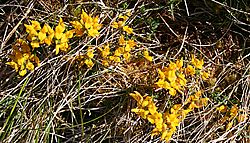Laymoor Quag facts for kids
Laymoor Quag is a special nature reserve in the Forest of Dean in Gloucestershire, England. It covers about 3.5 hectares (or 8.75 acres), which is roughly the size of five football fields! This area is super important for wildlife and is officially known as a Key Wildlife Site (KWS).
The Forestry Commission owns Laymoor Quag. But since 1982, the Gloucestershire Wildlife Trust has been taking care of it. They work together to protect this unique place.
Contents
Where is Laymoor Quag and What's Its Story?
Laymoor Quag is a wet heath and marsh area. You can find it about half a mile northwest of Bilson Green, near Cinderford. It's a bit hidden, surrounded by old railway lines that used to carry coal. These lines are now quiet forest paths.
This area was once a busy mining spot. The reserve itself is split into two parts by an old railway embankment. Laymoor Quag is the last piece of a special wet heathland habitat that used to cover a much larger area. Sadly, most of it was lost hundreds of years ago due to coal mining and tree cutting. That's why protecting this small part is so important!
What Kind of Habitat Does Laymoor Quag Have?
Laymoor Quag is a mix of wet heathland and marsh. It has small ponds and wet spots called "scrapes." These help keep the ground wet, which is perfect for certain plants and animals.
- Wet Heathland: This part is like a damp, open field with special plants.
- Marshland: This area is even wetter, often water-logged, and home to different types of plants that love soggy ground.
- Ponds: The ponds are vital for creatures like dragonflies and new plants to grow.
- Embankments: The old railway banks are sunny in some spots and shady in others. This variety helps different butterflies and fungi to thrive.
Plants and Animals: Who Lives Here?
Laymoor Quag is home to many interesting plants and animals, especially those that love wet places.
Plants of the Heathland
The northern part of the reserve is mostly heathland. Here you'll find:
- Purple Moor-grass
- Mat-grass
- Petty Whin: This is a very special plant that grows a lot here. In fact, Laymoor Quag is the only place in the whole county where it's found!
- Heather
- European Gorse
You can also see other pretty heathland flowers like:
- Heath Bedstraw
- Lousewort
- Tormentil
- Sneezewort
Trees like Silver Birch and Alder grow on the old railway embankments. You might even spot some old tree stumps in the marsh, showing where bigger trees once stood.
Plants of the Marshland
The southern part of the reserve is marshland, which means it's very damp and often has standing water. This area is full of:
- Rushes
- Marsh-marigold (a bright yellow flower)
- Cuckooflower
- Meadow-sweet
- Ragged-robin
- Lesser Spearwort
- Common Marsh-bedstraw
Pond Life and Important Species
The ponds and a natural spring at the edge of the reserve create a swampy home for plants like Yellow Iris and Skullcap, along with different kinds of bog mosses.
A second pond was dug in 1984. It's now a busy place, especially for dragonflies. It also provides a safe home for the Great Crested Newt, which is a protected species.
How Laymoor Quag is Protected
The people who manage Laymoor Quag work hard to keep it healthy.
- Grazing: Forest Sheep have helped keep the plants in check for a long time.
- Controlling invasive plants: They also work to stop plants like Bracken from taking over.
- Protecting Petty Whin: To make sure the rare Petty Whin plant is safe, they've put up fences around it.
Exploring Laymoor Quag
If you love nature walks, there are guides that tell you all about the Forest of Dean, including Laymoor Quag. You can find out where to see wildlife and enjoy the beautiful scenery. Two helpful guides are Where to see Wildlife in the Forest of Dean and Heart of the Forest Wildlife Walk.


